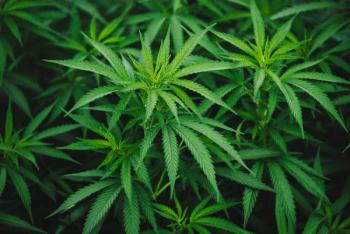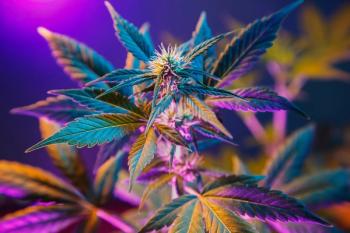
Cannabis and Chronic Pain
Based on his 13 years of clinical experience, Dr. Dustin Sulak explains strategies in effectively treating chronic pain while reducing or eliminating adverse effects.
Chronic pain is the most common reason people use cannabis for therapeutic purposes, and one of the conditions for which the most substantial evidence supporting its safety and efficacy exists. Beyond its ability to reduce the intensity of pain, when used optimally, cannabis can also reduce the impact of pain on mental health, sleep, and productivity. Emerging evidence supports the use of cannabidiol (CBD)-dominant preparations for chronic pain, though benefits are often more modest than those associated with tetrahydrocannabinol (THC). Other cannabinoids, such as cannabidiolic acid (CBDA) and cannabigerol (CBG), are gaining popularity for treating pain because of their distinct mechanisms of action. Strategies for effective use of cannabis in treating chronic pain, based on Dr. Sulak’s 13 years of clinical experience, can improve benefits and reduce or eliminate adverse effects.
Chronic pain is a common medical condition for which conventional treatments are often inadequate or dangerous. According to the 2016 National Health Interview Survey, an estimated 20.4% (50.0 million) of US adults had chronic pain, defined as pain on most days or every day in the past 6 months, and 8.0% of US adults (19.6 million) had “high-impact chronic pain,” defined as chronic pain that limited life or work activities on most days or every day during the past 6 months (1).
Chronic pain is also the most common reason people use cannabis for therapeutic purposes (2), and one of the conditions for which the most substantial evidence supporting its safety and efficacy exists (3). Due to stigma and lack of education among both patients and clinicians, cannabis is often used as a last-resort treatment for chronic pain, considered by many patients only after failing to benefit from surgery or opioid drugs.
This needs to change. In my experience, the medically-supervised use of cannabis is safer than any opioid or non-opioid pharmacotherapy, including over-the-counter medicines like acetaminophen (Tylenol) and nonsteroidal anti-inflammatory drugs such as ibuprofen. Even when used as directed, these drugs can cause liver injury, gastrointestinal ulcers, and more. Cannabis is also more effective than these treatments, as demonstrated by copious data on the use of cannabis as a substitute for other pain medications.
Interestingly, the preference of thousands of people for cannabis over alternatives is not necessarily because it’s a superior analgesic. In fact, the ability of cannabis to decrease pain intensity is often modest at best. The satisfaction expressed by people with chronic pain who use cannabis is more related to its holistic effects on the perception of and reaction to pain, and reduction of associated symptoms such as spasticity, inflammation, disturbed sleep, depressed mood, and anxiety. People also prefer cannabis because of its versatility in composition and delivery methods, allowing for highly individualized treatments. In addition, people who use cannabis to treat pain usually experience more self-empowerment and active involvement in their treatment, with greater freedom to adjust their regimen compared to traditional pharmacotherapies.
Clinical Evidence
Several meta-analyses (statistical analyses that combine the results of multiple studies) have been performed on cannabis or cannabinoids for chronic pain, with most, but not all, reporting significant benefit. Interestingly, the clinical trials do not suggest that any particular type of pain is more likely to respond to cannabis, perhaps due to its activity at multiple sites controlling pain signaling and pain perception. Chronic neuropathic, musculoskeletal, and inflammatory pain can all be effectively treated with cannabis, and many patients experience pain from a combination of these causes.
In the 2017 National Academies of Sciences, Engineering, and Medicine (NASEM) comprehensive report, chronic pain was one of three conditions for which authors found substantial or conclusive evidence that cannabis could be an effective treatment (4). The authors based their conclusions primarily on a 2015 review, which evaluated 28 randomized trials with 2454 participants who had different causes of pain, including neuropathy, cancer pain, fibromyalgia, and others. Cannabis or cannabinoid treatment was found to increase the odds of >30% pain reduction by approximately 40% more than placebo (5).
While the gold-standard randomized controlled clinical trials (RCTs) usually find cannabis superior to placebo, these studies seldom reveal the true power of cannabis in the treatment of chronic pain. First, they usually use low-quality cannabis supplied by the National Institute of Drug Abuse (NIDA). The cannabinoid levels in NIDA research-grade cannabis (~5% tetrahydrocannabinol [THC]) have been shown to be significantly divergent from commercially available cannabis from Colorado, Washington, and California (averaging ~18% THC); NIDA samples also contained 11-23 times more cannabinol (CBN) than state samples (likely due to aging in poor storage conditions) (6).
RCTs face another limitation compared to real-world treatment of chronic pain with cannabis: they usually limit the personalized fine-tuning of the cannabis treatment regimen we so often employ clinically to improve results. Trials prevent the use of multiple delivery methods, various ratios of cannabinoids, baseline treatment with flexibility for additional treatment of breakthrough symptoms, and so on. These are all common strategies for improving the benefits of cannabis and decreasing adverse effects when treating chronic pain.
Finally, most RCTs evaluate short-term treatment, often a month or two at most. While this is enough time to detect an improvement, some of the benefits of cannabis continue to grow over time and are remarkably sustained after several years of treatment.
Observational studies that capture real-world data on people using cannabis to treat chronic pain usually demonstrate more impressive results than RCTs. For example, among 2112 patients (76.1% female, average age 59 years) treated with cannabis for chronic pain in Colombia, 92.5% reported some improvement in their symptoms. More than 70% of the subjects reported at least 50% improvement in pain overall, and these benefits were maintained for at least 6 months (7).
Another recent large, long-term observational study in Australia reported similar results. Among 3691 previously cannabis-naïve patients (average age 56 years) who were treated with cannabis for two years, chronic pain was the primary condition in 72% of subjects. On average, pain severity improved 22% and pain’s inter-reference in activities improved 26% compared to baseline scores. Furthermore, depression and anxiety each improved 25%, emotional well-being improved 37%, and physical function improved 34% (8).
These large, long-term, real-world cohorts do a better job informing our expectations around using cannabis to treat chronic pain: very few people will find cannabis totally ineffective, and most will continue to use cannabis after trying it due to the improvements in pain and function with minimal adverse effects. Some will experience seemingly miraculous results, for others the benefits will be modest, and most will note improvements in a variety of other symptoms.
Does CBD Work for Chronic Pain?
The evidence supporting the use of cannabidiol (CBD)-dominant cannabis for pain is much less substantial than that of THC, but it is growing. For example, one open-label study found that in 31 subjects with diabetic peripheral neuropathy, treatment with CBD 20 mg 3x daily for 21 days resulted in a subjective decrease in pain for all patients. One third of the participants noted a decrease in pain within 24 h of starting, while the other two-thirds noticed improvement after 7 days. In addition, 23 of the 31 subjects were taking prescription pain medications, and all of them asked to decrease or discontinue the medication during the three-week trial (9).
Another recent open-label study followed 2816 subjects who used one of 13 brands of CBD products over four weeks, and collected survey responses on pain, anxiety, sleep, and quality of life. The results of those taking CBD products were compared with a control group of individuals on a waiting list. Those taking CBD reported an average 35% improvement in pain, with the largest decrease in pain score was observed in the first week of treatment (10).
In my clinical experience, CBD products can be helpful for mild and moderate chronic pain, but high doses are often needed, and this can get expensive. The most effective products contain low amounts of THC (so-called “full spectrum” products), and when people require large doses for pain relief, I often wonder if it’s the CBD that’s helping, the sometimes-substantial amounts of THC, or, most likely, a combination of both.
The Most Effective Hemp-Based Products for Chronic Pain
In the last few years, I’ve observed several patients who find relief from chronic pain using two more recently available hemp-based cannabinoids: cannabidiolic acid (CBDA) and cannabigerol (CBG).
CBDA is the precursor of CBD produced by the cannabis plant; it converts to CBD slowly at room temperature, or rapidly when exposed to high temperatures. Overall, my patients have found CBDA to be more effective in treating pain, and usually at lower doses, compared to CBD.
CBD and CBDA share many physiologic properties, but also have some important differences. CBDA is up to 11 times more bioavailable when taken by mouth (11). CBDA and CBD have both been shown to have anti-inflammatory properties, but may act via different mechanisms; unlike CBD, CBDA has been shown to inhibit the COX-2 enzyme, a common target of conventional anti-inflammatory medications (12).
In a variety of animal studies, CBDA has proven to be much more potent than CBD; in some cases, thousands of times more potent. In one rodent model of pain and inflammation, orally administered CBDA was effective at 1/100th of the dose required with CBD (13).
One important difference between CBD and CBDA has to do with their coadministration with THC. Many people use CBD to mitigate the adverse effects of THC, thus allowing them to tolerate a higher dose and achieve better pain relief. CBDA does not share CBD’s activity at the CB1 receptor and therefore does not alter the side effects of THC. For those wishing to decrease their sensitivity to THC, combining with CBD may be a better option; for those who do well with THC and want to experience its full power plus additional anti-inflammatory and other benefits, I recommend combining it with CBDA.
CBG can also help with pain and spasticity. While it has some overlapping mechanisms of action with both CBD and THC, CBG has some unique properties among the major cannabinoids, including its ability to suppress the sympathetic nervous system via the alpha-2 adrenoceptor (14); CBG is also an even more potent COX-2 inhibitor than CBDA (15). One survey found that among 48 adults using CBG to treat chronic pain, 74% felt it was superior to conventional medicines (16).
My patients report that both CBDA and CBG are effective for pain at lower doses than CBD, making them a more cost-effective strategy. Most adults find relief in the 5–50 mg range per dose. In general, CBDA seems to be more effective for joint pain, while CBG may be more often effective in nerve pain, although both seem to be versatile in various types of pain.
Can Cannabis Help Acute Pain?
Compared to chronic pain, acute pain is less likely to respond and more likely to be exacerbated by cannabis. Eleven randomized controlled trials of cannabinoids for experimentally induced or acute postoperative pain on 238 participants showed no or weak pain-relieving effects from a variety of cannabinoid doses and routes of administration. The best results were achieved in the medium dose range, and several studies found cannabinoids actually increased the intensity of acute pain (17).
There is some evidence that, for acute pain, improvement in pain is more likely in experienced cannabis users and increased pain is more likely in cannabis-naïve individuals; I have observed this in my clinical practice. Furthermore, many of my experienced patients report, especially with inhaled cannabis, a brief increase in acute pain intensity followed by longer-lasting relief.
Newer data suggests that appropriate oral dosing of THC can be helpful in acute post-traumatic pain, even in cannabis-naïve individuals. For example, in a study of 66 patients hospitalized for traumatic injury, treatment with synthetic THC capsules (5–10 mg twice daily for most patients) resulted in an average reduction of 79 morphine mg equivalents of opioid medications over 48 h, when compared with matched controls who did not receive THC. Patients who were not regular cannabis users clearly benefited from the oral THC for their acute pain, though the regular cannabis users in this cohort had somewhat better results (18).
Beneficial Psychoactive Effects
Many individuals with chronic pain experience more than just a painful sensation. They may find themselves dwelling on the pain, feeling anxious about future pain, and behaving in a way that leads to social isolation. Beyond helping with pain and other symptoms, cannabis, especially when used in a way that at least occasionally produces psychoactivity, often helps people unbundle these aspects of their condition.
The transformative unbundling is detailed in Figure 1. Pain isn’t pain until it reaches the brain; before that, it’s considered a nociceptive signal from a sensory nerve. Various parts of the brain can interpret that signal as pain, assign meaning to it, react to it emotionally, pay attention to the pain or ignore it, and perhaps most importantly, modify behavior in the context of pain. “Pain behaviors” can include decreased activity, guarded movements, facial and vocal expressions of pain and irritability, others’ reactions to these expressions, social isolation, absenteeism from work, and ultimately disability.
Every so often I see patients who, at first, experience all these aspects of their condition as a bundle of pain and misery. Over time, especially when using cannabis in a way that shifts their consciousness, they are able to untangle these into more distinct components of their experience; this gives people more power to transform each and to improve the overall condition.
Many people effectively employ strategies that allow for the effective treatment of pain without experiencing any of the psychoactive effects of cannabis. This is useful, since people typically need to avoid impairment while working or caring for their families. I strongly believe, however, that most of these people would also benefit from, in the right setting, occasionally taking a higher dose of THC that does produce psychoactivity and even significant impairment. This experience can open doors to new perspectives on their condition, increase their resilience, and help them feel more like themselves.
Conversely, I’m met many people who enjoy the pain-relieving effects of cannabis, but only use their medicine in the evenings after their work or other responsibilities are over; they suffer through the day without cannabis because they don’t realize they can likely use it in a different, non-impairing way that will actually improve their performance. Cannabis is so versatile, and I believe that most people with chronic pain would do well to learn how to use it in both non-impairing and more psychoactive ways; both can provide powerful and distinct benefits.
Cannabis Versus Opioids
A large amount of observational data has shown that people with chronic pain who use opioids are often able to reduce their opioid dose, or discontinue opioids altogether, after starting cannabis. A full review of this topic is beyond the scope of this article, but I’ll share data I published from three clinics in New England that followed the protocol in
Among 525 people who had used prescription opioids to treat chronic pain for at least three months, after adding cannabis, 204 people (40.4%) reported stopping opioids completely and 228 (45.2%) reported some decrease in their opioid usage, while only 67 (13.3%) reported no change in opioid usage and 6 (1.1%) reported an increase in opioid usage. Most importantly, 420 (80%) reported improved ability to function and 457 (87%) reported improved quality of life after starting cannabis (20). These results are far from unique. Several observational, real-world studies have demonstrated similar rates of opioid substitution among people with chronic pain.
As mentioned above, it’s too bad that so many people find cannabis after realizing the numerous problems associated with long-term opioid use. Perhaps this is changing: one study found that cannabis legalization is significantly associated with reductions in opioid prescribing (21). Another compared adding on long-acting opioids with adding on THC and CBD spray (nabiximols) to people with poorly controlled chronic pain: after six months, the cannabinoid group had more improvement in symptoms and far fewer negative side effects (22). This type of data, combined with the increasingly obvious need for an alternative to opioids, could gradually change the practices of mainstream medical chronic pain management.
I’ve observed that some people with chronic pain do well with a combination of cannabis and opioids. Cannabis can make the pain-relieving effects of opioids stronger, allowing people to use lower doses, prevent or slow the development of tolerance to the opioids, allowing for a more sustainable treatment, and address the pain bundle described above, preventing or reversing the psychological side effects of long-term opioid use.
How Safe Is It to Use Cannabis for Chronic Pain?
Cannabis is distinct from other treatments for chronic pain because it is extremely unlikely to cause any serious or lasting side effects. Even major overdoses are not fatal (but can be uncomfortable enough to make people think they’re dying).
Compare this to acetaminophen, the most common cause of fulminant liver failure in the developed world (23), and the drug most commonly implicated in many liver transplantation registries (24). The non-steroidal anti-inflammatory drugs (NSAIDs), sold over-the-counter, increase the risk of gastrointestinal ulcers, bleeding, hypertension, kidney injury, heart attacks, and stroke when taken at appropriate doses (25). Prescribed opioids are responsible for 75% of all drug overdose deaths (26), and even when used appropriately, their long-term use increases the risk of falls, fracture, hormone dysfunction, intensification of pain, and more.
Conversely, almost all adverse effects from cannabis are mild, transient, and easily mitigated by adjusting the treatment regimen. This is clearly demonstrated in the large Australian cohort described above: among 3961 previously cannabis-naïve patients who were treated with cannabis and followed for two years, only 77 “severe” treatment related side effects were identified (less than 2% of the subjects). The most common were nausea, diarrhea, loose stool, sedation, and headache, and all resolved with a dosing adjustment or discontinuation of cannabis. In the same cohort, there were two “serious” side effects, defined as requiring hospitalization or lifesaving intervention: one case of mania and one episode of hallucination.
In other words, 98% of the cohort experienced only mild or moderate adverse effects, if any. The most common (in order of prevalence) were sedation, dry mouth, dizziness, nausea, difficulty concentrating, and “feeling high.” As described above, feeling high can be beneficial in the right context.
Treatment Strategies for Chronic Pain:
- Set realistic expectations: cannabis is unlikely to make the pain vanish, but it is likely to decrease its intensity, make it less bothersome, and provide a host of other beneficial effects. Identifying concrete goals related to function can be helpful.
- I usually start with oral dosing, titrate to maximum beneficial effect over 2-6 weeks, and then add inhaled cannabis if needed.
- Oral products that can be incrementally titrated, such as drops, are often the best for precision dosing. Products that contain a broad spectrum of the plants constituents usually work better than isolated cannabinoids.
- Prioritize correcting sleep disturbances. Poor sleep increases one’s sensitivity to pain (27).
- The typical oral starting dose of THC for non-cannabis users is 1–3 mg of THC.
- In some cannabis-naïve patients with chronic pain, I start with 3–14 days of evening-only dosing. This can give the person a chance to get used to THC, to gently build tolerance to the psychoactivity and any side effects. I find this often improves the pain-relieving response when daytime dosing is started.
- Combine THC, even in low doses, with other cannabinoids, for daytime treatment: 25–50% of one’s night-time dose of THC is usually effective and well-tolerated.
- For people sensitive to THC’s side effects, CBD is the best adjunct. Try at 1:4 THC:CBD ratio or less.
- For people who do well with THC, consider adding in tetrahydrocannabinolic acid (THCA) and CBDA, especially for inflammatory pain. I usually recommend equal doses of THCA and THC, and CBDA in the range of 5–50 mg per dose.
- CBD-dominant treatment may be helpful in some patients but usually requires higher doses than combined THC and CBD and may be cost-prohibitive.
- A growing number of patients are experiencing good results using CBG to treat pain, often in the range of 10–50 mg 2–3x daily. This may be especially helpful in neuropathic and gastrointestinal pain.
- Most people who successfully use cannabis to treat chronic pain use two or more delivery methods.
- Use oral cannabis for baseline treatment as described above.
- Use inhaled cannabis for breakthrough pain and trouble falling asleep.
- For episodic types of pain, like migraine headache, use inhaled cannabis at the earliest signs of an episode.
- For localized pain, topical cannabis products work very well.
- Explore the psychoactive effects of cannabis in a safe and comfortable setting.
- Use cannabis to enhance the beneficial effects of nonpharmacological treatments such as exercise, physical therapy, and mindfulness. Inhaling a small amount of cannabis before these activities can make them more enjoyable and accelerate progress.
Conclusion
Cannabis is likely the most effective and safe medical treatment for chronic pain. Human clinical data supports this statement, but the details of the real-world experiences of people using cannabis for pain are even more important. Personalized treatment using two or more methods of delivery, combining THC with other cannabinoids, and intentionally reaping the benefits of cannabis’ psychoactive effects are the keys to fully unlocking its power to replace more dangerous treatments, reduce suffering, improve function, and improve quality of life.
References
- Dahlhamer, J., Lucas, J., Zelaya, C., Nahin, R., Mackey, S., DeBar, L., ... & Helmick, C. Prevalence of chronic pain and high-impact chronic pain among adults—United States. Morbidity and Mortality Weekly Report, 2018, 67(36).
- Sexton, M., Cuttler, C., Finnell, J. S., & Mischley, L. K., A cross-sectional survey of medical cannabis users: patterns of use and perceived efficacy. Cannabis and cannabinoid research, 2016, 1 (1), pgs. 131-138.
- National Academies of Sciences, Engineering, and Medicine, The health effects of cannabis and cannabinoids: The current state of evidence and recommendations for research. National Academies Press.
- National Academies of Sciences, Engineering, and Medicine, The health effects of cannabis and cannabinoids: The current state of evidence and recommendations for research. National Academies Press, 2017.
- Whiting, P. F., Wolff, R. F., Deshpande, S., Di Nisio, M., Duffy, S., Hernandez, A. V., ... & Schmidlkofer, S., Cannabinoids for medical use: a systematic review and meta-analysis. Jama, 2015, 313(24), 2456-2473.
- Vergara, D., Bidwell, L. C., Gaudino, R., Torres, A., Du, G., Ruthenburg, T. C., ... & Kane, N. C., Compromised external validity: federally produced cannabis does not reflect legal markets. Scientific Reports,2017, 7, 46528.
- Moreno-Sanz, G., Madiedo, A., Hernandez, P., Kratz, J., Aizpurua-Olaizola, O., Brown, M. R., ... & Mendivelso, F. O., Sex-dependent prescription patterns and clinical outcomes associated with the use of two oral cannabis formulations in the multimodal management of chronic pain patients in Colombia. Frontiers in Pain Research, 2022, 3.
- Vickery, A. W., Roth, S., Ernenwein, T., Kennedy, J., & Washer, P., A large Australian longitudinal cohort registry demonstrates sustained safety and efficacy of oral oral medicinal cannabis for at least two years, medRxiv, 2022.
- Kimless D, Caloura MK, Kirakosyan A, Goldner S, The effects of cannabidiol-based sublingual tablets on diabetic neuropathic pain, J Diabetes Metab, 2020.
- Saleska, J. L., Pauli, E. K., Rezvan, P., Cobb, O., Chen, J., Thorogood, P., ... & Laird, K. T., The Safety and Effectiveness of Commercially Available Cannabidiol Products for Health and Well-Being: A Randomized, Multi-Arm, Open-Label Waitlist-Controlled Trial. Integrative Medicine Reports, 2022, 1(1), pgs. 215-226.
- Pellesi, L., et al. Pharmacokinetics and tolerability of oral cannabis preparations in patients with medication overuse headache (MOH)—a pilot study, European journal of clinical pharmacology, 2018, 74 (11), pgs. 1427-1436.
- Takeda, S., et al. Cannabidiolic acid as a selective cyclooxygenase-2 inhibitory component in cannabis, Drug Metabolism and Disposition, 2008,36 (9), pgs. 1917-1921.
- Rock, E. M., Cheryl L. L., and Parker, L. A., Effect of cannabidiolic acid and ∆ 9-tetrahydrocannabinol on carrageenan-induced hyperalgesia and edema in a rodent model of inflammatory pain, Psychopharmacology, 2018, 235, pgs. 3259-3271.
- Cascio, M. G., Gauson, L. A., Stevenson, L. A., Ross, R. A., & Pertwee, R. G., Evidence that the plant cannabinoid cannabigerol is a highly potent α2-adrenoceptor agonist and moderately potent 5HT1A receptor antagonist, British journal of pharmacology, 2010, 159(1), pgs. 129-141.
- Ruhaak, L. R., Felth, J., Karlsson, P. C., Rafter, J. J., Verpoorte, R., & Bohlin, L., Evaluation of the cyclooxygenase inhibiting effects of six major cannabinoids isolated from Cannabis sativa, Biological and Pharmaceutical Bulletin, 2011, 34(5), pgs. 774-778.
- Russo, E. B., Cuttler, C., Cooper, Z. D., Stueber, A., Whiteley, V. L., & Sexton, M., Survey of patients employing cannabigerol-predominant cannabis preparations: Perceived medical effects, adverse events, and withdrawal symptoms, Cannabis and Cannabinoid Research, 2022, 7(5), pgs. 706-716.
- Reviewed in Karst, M., Wippermann, S., & Ahrens, J., Role of cannabinoids in the treatment of pain and (painful) spasticity, Drugs,2010, 70(18), pgs. 2409–2438.
- Schneider-Smith, E., et al. Matched pilot study examining cannabis-based dronabinol for acute pain following traumatic injury, Trauma Surgery & Acute Care Open, 2020, 5(1).
https://healer.com/blog/medical-cannabis-opioid-guide/ - Takakuwa, K.M., and Sulak, D., A survey on the effect that medical cannabis has on prescription opioid medication usage for the treatment of chronic pain at three medical cannabis practice sites, Cureus, 2020, 12(12).
- Wen, J., et al. The impact of medical and recreational marijuana laws on opioid prescribing in employer-sponsored health insurance, Health economics, 2021, 30(5), pgs. 989-1000.
- Ueberall, M. A., et al. Effectiveness, Safety, and Tolerability of Nabiximols Oromucosal Spray vs Typical Oral Long-Acting Opioid Analgesics in Patients with Severe Neuropathic Back Pain: Analysis of 6-Month Real-World Data from the German Pain e-Registry, Pain Medicine, 2022, 23(4), pgs. 745-760.
- Reuben, A., et al. Outcomes in adults with acute liver failure between 1998 and 2013: an observational cohort study, Annals of internal medicine, 2016, 164(11), pgs. 724-732.
- Gulmez, Sinem Ezgi, et al. Liver transplant associated with paracetamol overdose: results from the seven-country SALT study, British journal of clinical pharmacology, 2015, 80(3), pgs. 599-606.
- Cooper, C., et al. Safety of oral non-selective non-steroidal anti-inflammatory drugs in osteoarthritis: what does the literature say?, Drugs & aging, 2019, 36(1), pgs. 15-24.
- Centers for Disease Control and Prevention, Number of poisoning deaths involving opioid analgesics and other drugs or substances—United States, 1999–2010, MMWR Morb Mortal Wkly Rep,2013, 62(12), pg. 234.
- Roehrs, T., Hyde, M., Blaisdell, B., Greenwald, M., & Roth, T., Sleep loss and REM sleep loss are hyperalgesic. Sleep, 2006, 29(2), pgs. 145-151.
About the Author
Dustin Sulak, DO, one of the first physicians in Maine to incorporate the legal use of cannabis as a medicine in 2009, is the founder of Integr8 Health, a medical practice that follows more than 8000 patients using medical cannabis. Today he is globally recognized by his peers as a pioneer of clinical applications, formulations, and usage protocols. He is the author of the first foundational text on the clinical use of cannabis and cannabinoid therapies, titled Handbook of Cannabis for Clinicians: Principles and Practice.
Dr. Sulak is co-founder of Healer, a medical cannabis brand founded to address the challenges of helping patients and health providers get the best results with safe, reliably dosable products and education on how to best use them. Healer’s distinctive product formulations and educational material are based on his work. For free education on how to use cannabis to get the best results or to become a trusted cannabis advisor by enrolling in Healer’s online training and certification program, visit
Newsletter
Unlock the latest breakthroughs in cannabis science—subscribe now to get expert insights, research, and industry updates delivered to your inbox.





